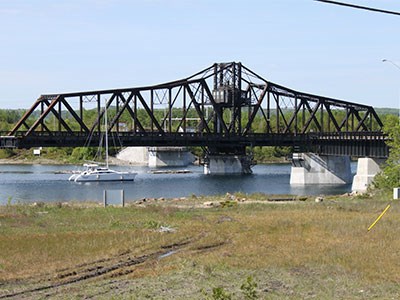The swing bridge at Little Current on Manitoulin Island is celebrating its centenary this year, and a local advocate hopes to see the anniversary act as a catalyst to make way for railway heritage tourism in the area.
A single-lane bridge that follows Highway 6 into Little Current, it’s the only land access connecting the island, located in Georgian Bay, to the mainland.
The steel structure, built for rail passage in 1913 by the Algoma Eastern Railway, swings open every hour, on the hour, to allow boat traffic passage through.
At one time, Little Current was the 11th busiest port on the Great Lakes, bringing in coal for all the North Shore of Lake Huron and commercial customers like Inco, and later shipping sulfur to Sault Ste. Marie and iron pellets to Cleveland, said Bill Caesar, a history buff who penned the book, Bridging the Centuries, with his son, Mike, last year.
The highway was built from 1926 to 1930, and the first truck came across the bridge in 1944. Eventually, the rails were removed and the bridge was converted for road traffic. Caesar said that change signalled the end of the railway, because truck transport was more efficient.
“I kind of think it was done on a very strict budget, because the rail speed was 10 miles an hour, and that’s why they called it The Agony,” Caesar said. “It was just so slow, and they would stop at anything. If a fisherman wanted a ride and he waved at the train, they would stop and pick him up and on they’d go. That all added to the travel time.”
Rail travel was also expensive. In the equivalent of today’s currency, a return trip during its heyday would have cost $168 per passenger, untenable for the average farmer or pioneer, and really only affordable for businessmen, politicians and wealthy U.S. travellers.
Manitoulin’s rail history is forgotten by many today, but Caesar is leading the call for Islanders to embrace that part of their history.
“I’d like to see people recognize it as a railway heritage site to go along with Capreol and Cochrane and all these other railway towns across the North,” Caesar said. “They are struggling for industry and tourism, and I think the railways are a real key.”
Little Current celebrated Bridge Fest Weekend in July and purchased a jigger—a car that ran the rails for maintenance and inspection purposes—that now sits proudly at the tourist information centre at the entrance to Little Current.
Sourcing the car from Tottenham in southern Ontario, Caesar learned it was the last jigger to be used between Espanola and Little Current before the rails were removed.
With $5.5 million in recent renovations to the bridge, including sandblasting and repainting of the superstructure and a refinishing of the deck, the Ministry of Transportation has deemed the bridge fit for another 30 years of service.
But Caesar believes it’s time the province started looking at alternatives, as the aging structure won’t last forever. A recent visit to Europe convinced him that an underground passageway, like the submarine Chunnel that extends between France and England, is the best option.
“I really think that would be the way to go,” he said. “If you want to leave this thing as a heritage structure, great—it looks wonderful and it does remind us of what our past is all about—but we do have to look at an alternative.”




